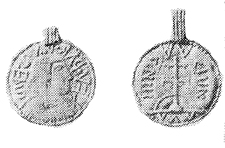Archaeologia Cantiana - Vol. 57 1944 page 73
a bishop of Autun in the sixth century. The puzzling inscription on the other side of the coin on either side of the cross, which may be NIII> or NIN>, he thought might refer to Nivernum.
Though his mistake was pointed out by the Rev. Daniel Haigh in Arch. Cant., Vol. VIII, p. 233, published in 1872, Roach Smith's reading was generally accepted.
But in the lately published Numismatic Chronicle for 1942, Sir Arthur Evans, in a posthumous article edited by Dr. E. T. Leeds, the Keeper of the Ashmolean Museum at Oxford, shows quite clearly the importance of the coin, and the true reading of the inscription.

It is undoubtedly LEUDARDUS EPS (= episcopus), Leudard the Bishop, and if we want to find his story we have only to look at Bede's Ecclesiastical History, Book 1, ch. 25, where we read that "Ethelbert, King of Kent,
had a Christian wife of the royal family of the Franks (she was the daughter of Charibert, King of Paris) called Bertha, whom he had received from her parents on condition that she should be permitted to practise her religion with the Bishop Luithard, who was sent with her to preserve her faith"; and a little farther on, in the 26th chapter, Bede says, "There was on the east side of the city a church dedicated to the honour of St. Martin, built whilst the Romans were still on the island, where the Queen, who, as has been said before, was a Christian, used to pray."
This Luithard, or Letard as he was later called, was buried on the north side of the porticus of St. Martin, where Ethelbert and Bertha lay, in a corresponding position to St. Augustine in the porticus of St. Gregory, in the abbey church of St. Peter and St. Paul, against the inner wall of the porticus and east of the door into the church. This we know from the contemporary history of the Translation of St. Augustine by Goscelin in 1091. Some traditions say Luithard was Bishop of Senlis, some of Soissons, but he held no English See, so far as we know, and was simply Luithard the Bishop, the Queen's chaplain, which may be the reason for the absence of any territorial designation on the coin. Sir A. Evans points out that the various Frankish bishops and other people of importance issued their own coins, and that it wasDISCOVERIES AT DOVER.
DURING the past year, through destruction and subsequent exposure, various noteworthy details of construction and decoration have come to light. Careful records are kept by the Borough authorities, to whose kindness the following notes are due. As further features in this ancient inhabited valley of the Stour may be found, it is, at this stage, sufficient to note the following. 35 Clarence Street. Part of a fifteenth century wall built of two courses of small red bricks set upright and divided from the next two courses by a course
set flat. Guildhall Vaults, Bench Street. A late Tudor stone fireplace on an upper floor. Milestone Cafe, Snargate Street. A recess lined with eighteenth century Delph tiles depicting many scriptural scenes; and a curious drain recess, the back and sides lined with three Delph tiles.
The core of massive walls of St. Martin's le Grand now stand exposed with, to the S.W., other walls of an early character.
W.P.D.S.
RECOVERY IN KENT OF GLOUCESTERSHIRE MANORIAL ROLLS.
MANOR OF HARTPURY, CO. GLOUCESTER.SOME ancient parchment documents, discovered in a hedge at Upper Deal roughly rolled up and showing signs of exposure to the weather for a considerable time, were recently brought by the finder to the Editor, who was able to identify them as court rolls of the manor of Hartpury, Gloucestershire.
The rolls, consisting of eight loose parchment
membranes, were sent to the Public Record Office, whose staff effected such minor repairs as were necessary and were able to trace their rightful owner. The parchment was found to be in fair condition; and, though much of the writing was irremediably perished, enough legible entries remain to